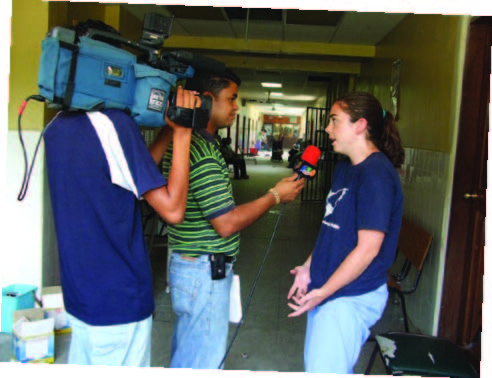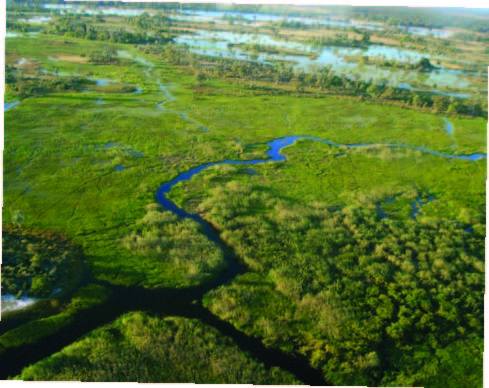Each summer, several undergraduate recipients of the Whiting School’s Vredenburg Scholarships receive funding to apply their engineering, technology, and applied science skills in an international setting. We checked in with three 2007 Vredenburg Scholars upon their return to Hopkins in the fall to find out more about their research and travels…

As a kid, Blair Johnson ’08 was afraid of waves. She wasn’t a strong swimmer and the thought of getting knocked over and rolled into the undertow filled her with horror. Back then, she never could have imagined herself as an undergraduate drawn to coastal engineering; in fact, she never knew such a discipline existed. Flash forward 15 years and Johnson found herself in Granada, Spain, where she passed her summer studying wave patterns, ports, breakwaters, and coastal structures.
Here in Baltimore, the civil engineering major spends much of her time in the basement of the Stieff Building studying the nature of waves. In particular, she’s interested in how waves dissipate over mud, because mud is more elastic than a harder surface like sand and absorbs more of the water’s energy. Her hours logged alongside the 20,000-gallon wave tank gave her the foundation—far more solid than mud—to land the Vredenburg Scholarship and further her research abroad.
In the gorgeous city of Granada, where centuries-old buildings stand against a backdrop of jagged peaks, Johnson worked in a lab of almost 30 people, most of whom—professors and doctoral students—were older and more experienced. “We worked on port and harbor construction, specifically creating a new breakwater design,” she says.
The existing breakwater in the Port of Gijon, north of Granada, can dissipate the waves during calm weather. But when weather turns severe, it can’t prevent the waves from battering the beach and port. “We designed a berm that would be an extension, serving as a sort of sandbar in front of the existing concreteblock breakwater, which would help break the waves at an earlier point in their pattern, especially during storms,” says Johnson.
The breakwater design is being finalized, and its construction in the Port of Gijon should be complete within a year, she notes.
The young engineer says she chose to pursue coastal engineering because it would allow her to combine her interests in waves and oceans with structural engineering. “And, I’d get to travel to some amazing places all over the world.”
Her summer abroad as a Vredenburg Scholar didn’t disappoint. “I absolutely loved the culture there,” she says. At first she was surprised when everything shut down from 2 to 5 p.m. every day for siesta. “But soon I learned the pleasure—and importance—of reading a book by a fountain or spending a day walking in the countryside with a friend. People there are incredibly productive, but they also take the time to enjoy the good moments.”
And although she still isn’t a strong swimmer, Johnson hopes to return to the lab—and to the ocean—for a year of post-graduate work. “There is so much more to learn and do in Granada,” she says. “My summer there opened up the world for me.”

Julia Dixon ’08 spent one month training in Costa Rica and a second month in the town of Olanchito in Honduras where she repaired biomedical devices in a small public hospital. A pre-med student majoring in biomedical engineering, Dixon wanted to combine her studies in medicine and engineering. Working with a student partner from the Engineering World Health Summer Institute and a technician from the International Aid’s Medical Equipment Training Program, Dixon devoted her days to finding workable fixes for blood pressure cuffs, EKG machines, pulse oximeters, and nebulizers— all key equipment for a basic hospital. Because their funding was limited, Dixon and her colleagues had to be creative in their approach to repairs, such as switching or rebuilding parts from several broken oximeters to create a single functioning one.
“The work was often frustrating because we didn’t have the resources we needed,” says Dixon. “But I definitely think the summer gave me a full picture of what health care is like in developing countries. I was impressed that the clinicians would do their work every day with so few resources— and make a difference in the lives of so many people.
“As a physician,” she says, “I would like to return to Honduras or another Latin American country. If we in the United States are to help hospitals in [developing nations], we need to tailor our solutions based on their resources. It’s not just a matter of shipping them state-of-the-art equipment.”

Although he grew up in Botswana, Vredenburg Scholar Kwadwo Tettey ’08 gained a deeper insight into his homeland during his summer doing HIV/AIDS research. Working at the Botswana-Harvard Partnership for HIV Research and Education in the capital city of Gaborone, the chemical and biomolecular engineering major studied protein expression versus viral load in HIV/AIDS. The goal: to deepen understanding of the dynamics of the virus and how it progresses.
When he wasn’t setting up experiments and analyzing data, Tettey would visit the nearby hospital. “My research became very real to me,” he says. “Walking the hospital corridors, I would see so many HIV/AIDS patients—men, women, children, every age and sort of person.”
Tettey plans to pursue graduate work in nanotechnology, hoping to combine that work with further HIV/AIDS research. “A lot of people around the world are working very hard to understand and combat HIV/AIDS,” he says. “It is not fast enough, but I believe scientists will come up with a cure. I would like to go back [to Botswana]. And someday I’d like to be a part of finding that cure.”




